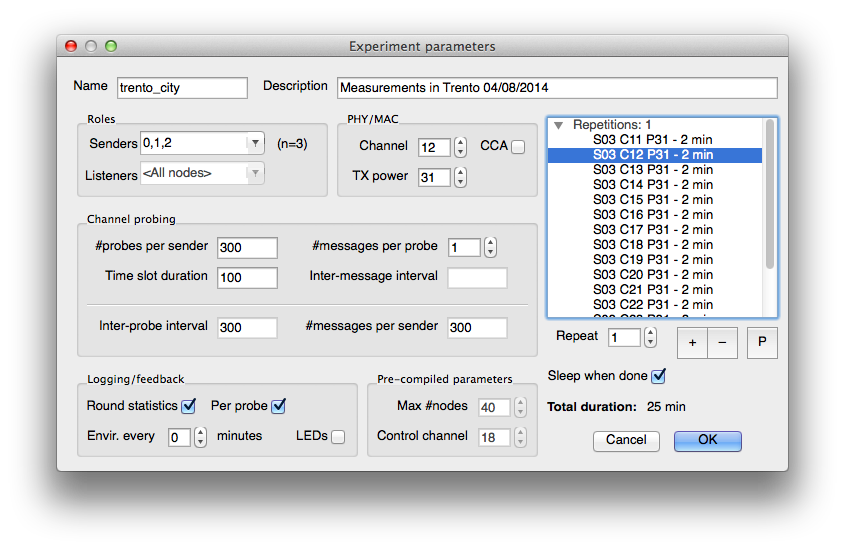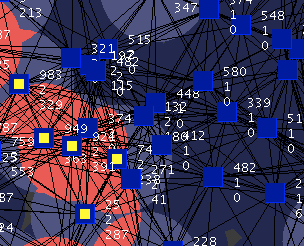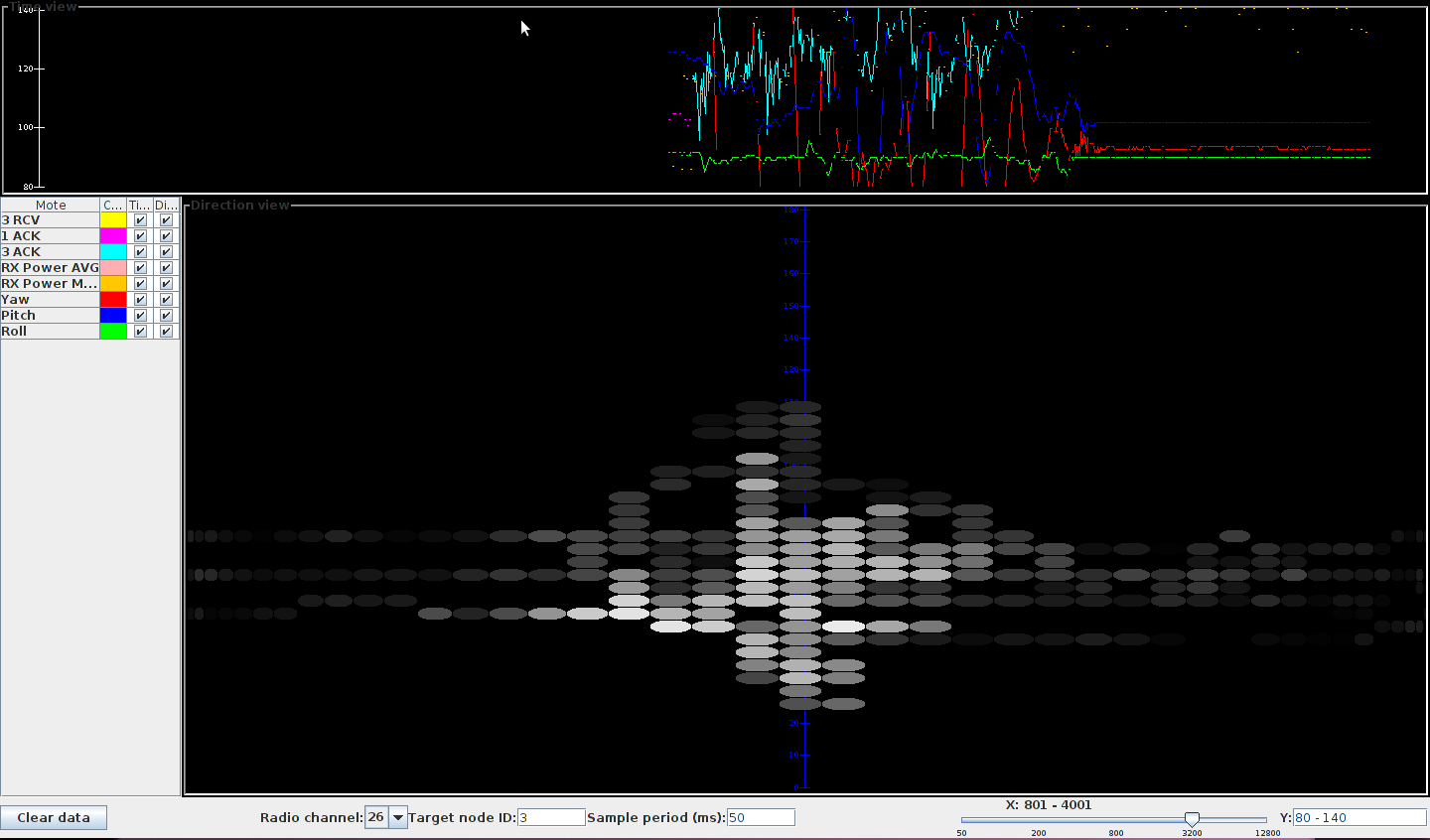Software
Software
TRIDENT is a software tool expressly designed to support in-field connectivity assessment by relying only on WSN nodes, without additional infrastructure, and the sharing of results uniformly over different experiments. It covers the entire workflow concerned with connectivity assessment experiments. After the WSN nodes are flashed with TRIDENT software, appropriate user interfaces enable the operator to (re)configure the experiments settings, discover nodes, and download the results. The latter are stored in a database, simplifying the storage and the offline analysis of the data gathered.
TRIDENT offers a simple visualization of the connectivity map built from available collected traces. A similar visualization is provided also for mobile nodes; once the tool is fed with a sequence of locations, it can “replay” the maps, showing to the operator how connectivity evolved due to mobility.
The database contains generic and customizable stored procedures for data manipulation. The set of pre-canned scripts allows the user to quickly plot trends derived from the data collected.
TRIDENT currently supports running experiments on two hardware platforms: TMote Sky with an integrated radio chip (CC2420) and WaspMote that relies on an extension module for radio communications, in our case the XBee S2 integrating the ZigBee-compliant EM2520 system-on-chip.
For getting the source see here.
TRIDENT offers a simple visualization of the connectivity map built from available collected traces. A similar visualization is provided also for mobile nodes; once the tool is fed with a sequence of locations, it can “replay” the maps, showing to the operator how connectivity evolved due to mobility.
The database contains generic and customizable stored procedures for data manipulation. The set of pre-canned scripts allows the user to quickly plot trends derived from the data collected.
TRIDENT currently supports running experiments on two hardware platforms: TMote Sky with an integrated radio chip (CC2420) and WaspMote that relies on an extension module for radio communications, in our case the XBee S2 integrating the ZigBee-compliant EM2520 system-on-chip.
For getting the source see here.
Programming Wireless Sensor Networks (WSNs) is currently perceived as a difficult task, an issue which may seriously hamper a widespread adoption of this technology. Most often, WSN programmers work at the level of the operating system, using basic communication primitives. Differently, TeenyLIME empowers WSN programmers with a higher level of abstraction by replacing the OS-level communication constructs with the notion of a shared memory space spanning neighboring (1-hop) nodes. TeenyLIME can be used to implement both application-level and system-level mechanisms, e.g., routing and MAC protocols. In addition, unlike most programming models in the WSN literature, TeenyLIME is extensively used in real-world WSN deployments, e.g., monitoring heritage buildings and control of road tunnels, where it provides a foundation to build efficient WSN systems with reduced programming effort.
The DiCE (Distributed Constraint Evaluator) system provides high-level, declarative constructs to describe network processes using safety properties which are monitored by an flexible accompanying runtime. The system not only monitors absolute properties such as "the temperature of any node must be below a given threshold", but also global properties such as "there should not be a temperature difference greater than a threshold". In their most general form, the properties consist of polynomial inequalities connected by logical operators. The polynomial variables represent the state of network nodes. The design allows the system to run on a heterogenous wireless network and to be easily reconfigured by adding or removing properties. Moreover, the monitoring takes place in a fully distributed and autonomous fashion.
More information and the source code for a proof of concept prototype running on top of TinyOS will be available soon.
More information and the source code for a proof of concept prototype running on top of TinyOS will be available soon.
Lime (Linda in a Mobile Environment) is a model and middleware supporting the
development of applications that exhibit physical mobility of hosts, logical
mobility of agents, or both. Lime adopts a coordination perspective inspired
by work on the Linda model. The context for computation, represented in Linda
by a globally accessible, persistent tuple space, is refined in Lime to
transient sharing of identically-named tuple spaces carried by individual
mobile units. Tuple spaces are also extended with a notion of location and
programs are given the ability to react to specified states. The resulting
model provides a minimalist set of abstractions that facilitates rapid and
dependable development of mobile applications.
TinyLIME is a middleware for wireless sensor networks (WSN) that departs from
the traditional WSN setting where sensor data is collected by a central
monitoring station, and enables instead multiple mobile monitoring stations to
access the sensors in their proximity and share the collected data through
wireless links. This intrinsically context-aware setting is demanded by
applications where the sensors are sparse and possibly isolated, and where
on-site, location-dependent data collection is required. An extension of LIME,
TinyLIME makes sensor data available through a tuple space interface,
providing the illusion of shared memory between applications and sensors. Data
aggregation capabilities and a power-savvy architecture complete the
middleware features.
One of the primary challenges for wireless sensor network (WSN) applications is energy management. An accepted solution that dramatically increases sensor lifetime is duty-cycling, i.e., periodically switching on and off communication and/or sensing capabilities. The major factors that affect lifetime are the length of the period (the epoch period) and the duration of the on-time (the awake interval). However, another variable critically affects the performance of the network, namely when in each period each node activates. We refer to this as the wake-up time of the sensor node. In most systems, the wake-up time is randomly established, relating only to when the sensor is initially activated.
This work illustrates an approach to modify, in a decentralized fashion, the wake-up time of WSN nodes, so that they are scattered as much as possible. We maintain that such wake-up scattering improves application performance in many situations:
- Responsiveness to Local Queries: Minimize the delay when a mobile base station queries for sensor data to nodes close to it, plus reduce the number of nodes awake at the same time to avoid the collisions produced by simultaneous query responses.
- Event Coverage: Maximize the percentage of events detected, applying the Wakeup Scattering technique to the duty cycle of the sensing devices.
- Data Latency in Tree-Based Networks: Minimize the latency of data transmitted from a child node to the sink, by adjusting the wakeup times of the nodes in the schedule.
MoteHunter is an award-winning tool for Wireless Sensor Network deployment and
maintenance, which can be used to localize lost WSN motes on the field. It uses a
directional antenna, a digital compass, and RSSI measurements, and it provides a
Java GUI to assist field work. It can be used to search for any mote compliant
with IEEE 802.15.4, although a special small-footprint software component can be integrated with the mote\92s application to improve the search process.
The MoteHunter hardware can be simply assembled from off-the-shelf components, and the software is open source. For assembly instructions and for getting the source see here.
The MoteHunter hardware can be simply assembled from off-the-shelf components, and the software is open source. For assembly instructions and for getting the source see here.

















